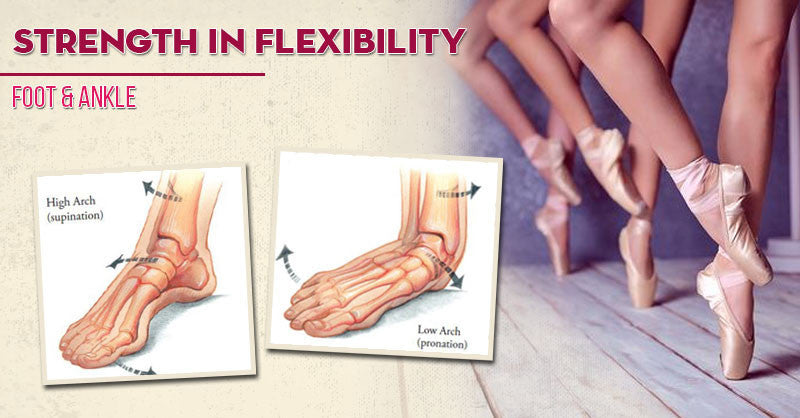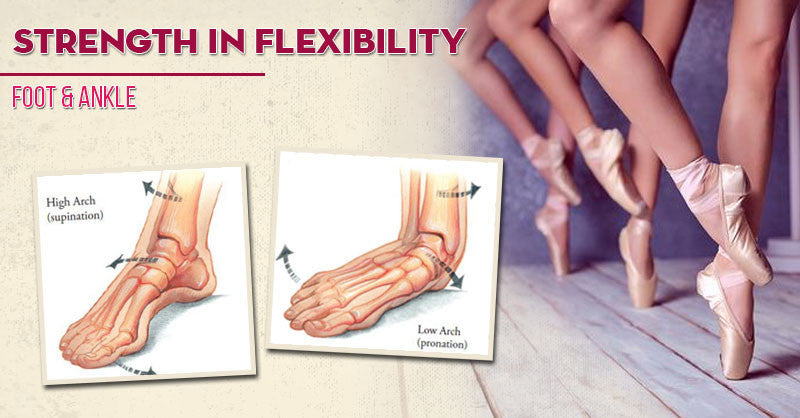Strength in Flexibility: Foot & Ankle – PART 3
Posted by EasyFlexibility Team on
Welcome back to the final installment of the Foot & Ankle series.

By this time, you have tried a few stretching and strengthening exercises on your own or with the help of the Foot and Ankle Flexibility Program. In PART TWO, a couple of challenges were brought to light that will be addressed below. Together we will review some solutions to these common difficulties and you will quite literally be able to put your best foot forward the next time you step into class!
Challenge 1: Controlled Relevé
The ideal relevé begins with the feet flat on the floor. From here, it rises in a straight, direct pathway, up to the highest position on the balls of the feet without waivering. As previously discussed in the first article, if the muscles on the inner or outer edges of the foot are stronger than the others, the imbalance will cause the foot to roll in or out. This causes instability can lead to injury.
Learn to prevent this from happening. Here is an an exercise that uses resistance to strengthen and stabilize the ankle:
- Stand facing the wall or barre, with right leg back in a small parallel lunge. Hold on to the wall or barre.
- Bend the right knee and place the left heel on top of the right foot.
- Press down with the left heel as you contract your right dorsiflexors (flex your right foot, lifting toes off the ground)
- Hold for a few seconds and release. Repeat.
- Repeat on left side.
You will notice many ballet dancers who pronate the foot on the extended leg during arabesque to create a continuation of the line. You may have heard this called “winging the foot”. This is merely an act of flexibility and there is no weight on the joint as the leg is lifted. When the ankle joint is bearing the weight of the body, especially during a one-legged balance, it is absolutely crucial to avoid any pronation or supination (turning in) of the ankle joint on the standing leg.
Challenge 2: Relevé Height

The beloved “banana foot” does not come easy and those dancers who are gifted these coveted arches should be thankful.
If you find you are only able to lift your heels a few inches off of the floor in relevé, try your hand (or foot) at this stretch for your dorsiflexors that will help you lift off:
- Sit on your knees, with tops of feet flat on the floor under your seat.
- Press the front of your lower legs into the floor, contracting the muscles.
- Hold for 5 seconds.
- Put your hand behind you for support and lift the knees straight up off the floor, pressing your seat into your heels.
- Hold for 5 seconds.
- Repeat all!
It is amazing what our feet and ankles are capable of besides their daily tasks such as walking from place to place. These exercises are only part of the Foot and Ankle Flexibility Program regime. With time and consistency, you will no doubt love your beautifully strong and flexible feet!
Get Your Foot and Ankle Program below:

© ElasticSteel Corp., EasyFlexibility, Paul Zaichik, et. El., 2022. No part of the materials available through ElasticSteel.com, EasyFlexiiblity.com, site may be copied, photocopied, reproduced, translated or reduced to any electronic medium or machine-readable form, in whole or in part, without prior written consent of Paul Zaichik EasyFlexibility.com, Elasticsteel.com.. Any other reproduction in any form without the permission of Paul Zaichik EasyFlexibility.com, Elasticsteel.com is prohibited. All materials contained on this site are protected by United States copyright law and may not be reproduced, distributed, transmitted, displayed, published or broadcast without the prior written permission of Paul Zaichik, EasyFlexibility.com, Elasticsteel.com.












